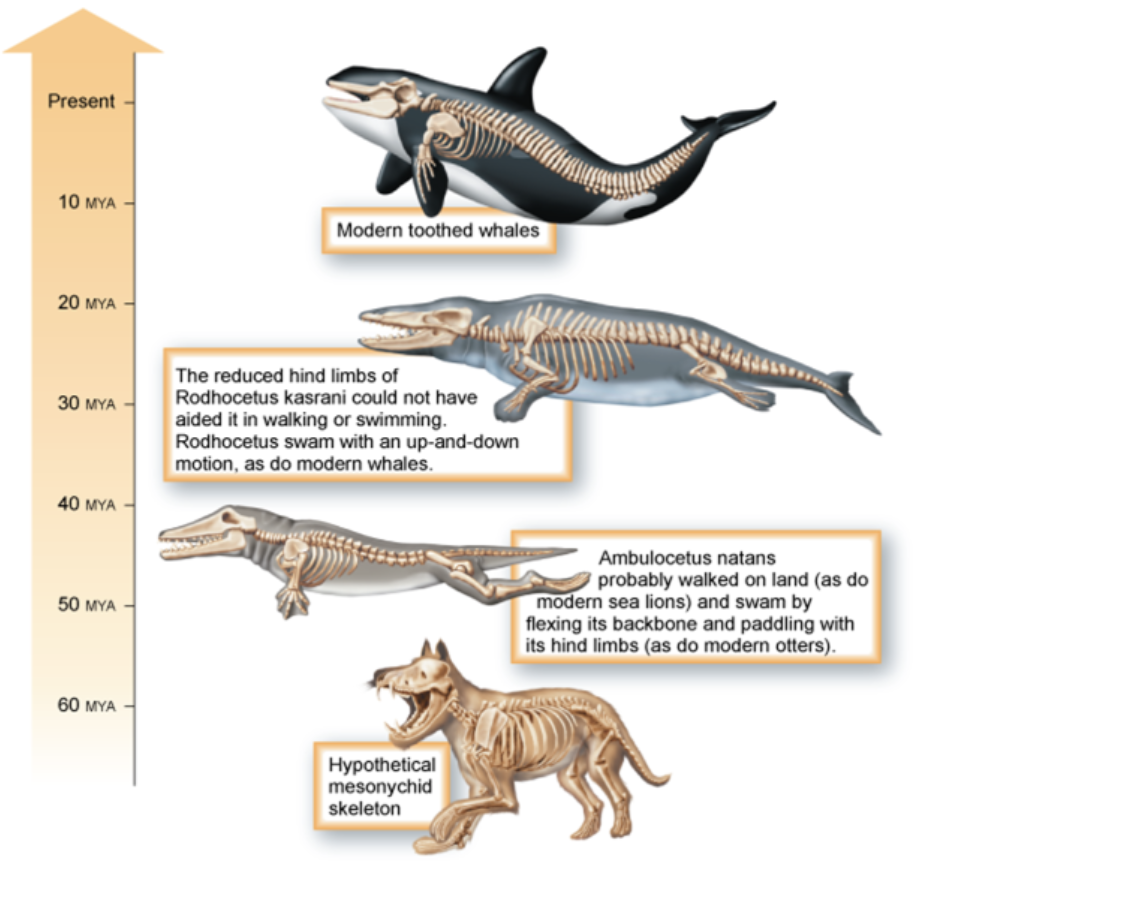Refer to the figure shown here. Which of the following would have been a selective agent or pressure that could lead to the reduction in hindlimbs through time? A) The animal's body size was too heavy to support the weight on land and hindlimbs were no longer useful. B) More emphasis was placed on flexing the backbone than on paddling with hindlimbs for swimming. C)Appendages cause resistance, or drag, when moving through water. D)With the increased size of the tail and its use in swimming, the hindlimbs were not as necessary. E)All of the above answers describe selective agents or pressures that could have led to the reduction in hind limbs over time.
Refer to the figure shown here. Which of the following would have been a selective agent or pressure that could lead to the reduction in hindlimbs through time? A) The animal's body size was too heavy to support the weight on land and hindlimbs were no longer useful. B) More emphasis was placed on flexing the backbone than on paddling with hindlimbs for swimming. C)Appendages cause resistance, or drag, when moving through water. D)With the increased size of the tail and its use in swimming, the hindlimbs were not as necessary. E)All of the above answers describe selective agents or pressures that could have led to the reduction in hind limbs over time.
Biology 2e
2nd Edition
ISBN:9781947172517
Author:Matthew Douglas, Jung Choi, Mary Ann Clark
Publisher:Matthew Douglas, Jung Choi, Mary Ann Clark
Chapter29: Vertebrates
Section: Chapter Questions
Problem 12RQ: During the Mesozoic period, diapsids diverged into. pterosaurs and dinosaurs mammals and reptiles...
Related questions
Question
Refer to the figure shown here. Which of the following would have been a selective agent or pressure that could lead to the reduction in hindlimbs through time?
A) The animal's body size was too heavy to support the weight on land and hindlimbs were no longer useful.
B) More emphasis was placed on flexing the backbone than on paddling with hindlimbs for swimming.
C)Appendages cause resistance, or drag, when moving through water.
D)With the increased size of the tail and its use in swimming, the hindlimbs were not as necessary.
E)All of the above answers describe selective agents or pressures that could have led to the reduction in hind limbs over time.

Transcribed Image Text:Present
10 MYA
Modern toothed whales
20 MYA
The reduced hind limbs of
Rodhocetus kasrani could not have
aided it in walking or swimming.
Rodhocetus swam with an up-and-down
motion, as do modern whales.
30 MYA
40 MYA
Ambulocetus natans
probably walked on land (as do
modern sea lions) and swam by
flexing its backbone and paddling with
its hind limbs (as do modern otters).
50 MYA
60 MYA
Hypothetical
mesonychid
skeleton
Expert Solution
This question has been solved!
Explore an expertly crafted, step-by-step solution for a thorough understanding of key concepts.
This is a popular solution!
Trending now
This is a popular solution!
Step by step
Solved in 3 steps

Knowledge Booster
Learn more about
Need a deep-dive on the concept behind this application? Look no further. Learn more about this topic, biology and related others by exploring similar questions and additional content below.Recommended textbooks for you

Biology 2e
Biology
ISBN:
9781947172517
Author:
Matthew Douglas, Jung Choi, Mary Ann Clark
Publisher:
OpenStax

Biology: The Dynamic Science (MindTap Course List)
Biology
ISBN:
9781305389892
Author:
Peter J. Russell, Paul E. Hertz, Beverly McMillan
Publisher:
Cengage Learning

Biology 2e
Biology
ISBN:
9781947172517
Author:
Matthew Douglas, Jung Choi, Mary Ann Clark
Publisher:
OpenStax

Biology: The Dynamic Science (MindTap Course List)
Biology
ISBN:
9781305389892
Author:
Peter J. Russell, Paul E. Hertz, Beverly McMillan
Publisher:
Cengage Learning